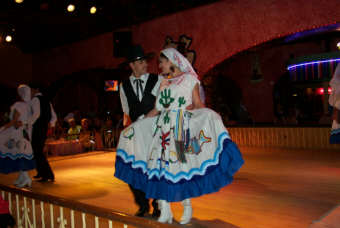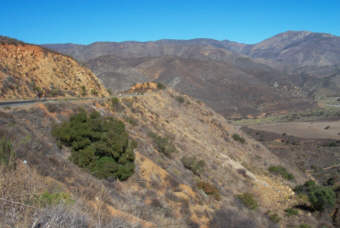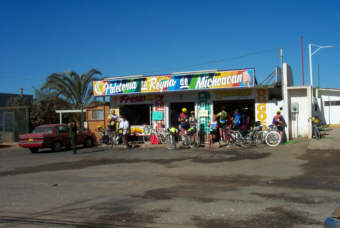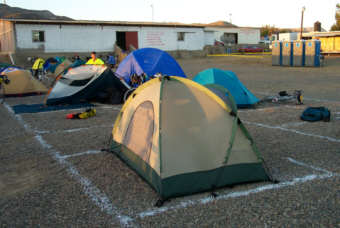

Mexico 
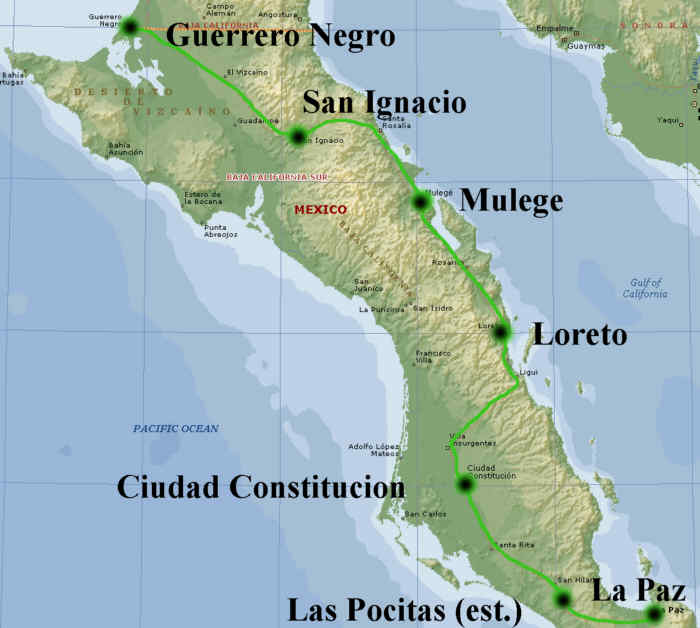
Notes
from Alice
Hi!
We are in Mulege enjoyng a layover day. I'm in the laundromat, thank god they
had one or much time would be consumed washing by hand. I am having a great time
and many folks are but there are a lot of whiners complaining about how hard the
trip is. I am amazed that these people didn't try riding the miles and camping
before they joined.
A friend has emailed me with some questions and has suggested that I answer them
on the website so that I have to answer them only once. Can you make a corner or
a column for FAQ? Assuming that you can I will attempt to answer her questions
here. If you can't maybe you can do them as a story when you change the web page
and they'll disappear after that.
FAQ
HOW
DOES ONE CONSUME 6000 CALORIES A DAY? Easily! We eat huge meals and snack
frequently on high calorie foods. We appreciate buffet style meals because we
can pile on all the food that we want. During a ride we munch on the goodies we
carry in our bike bags or buy along the way. Some riders make it a point to eat
every hour. A big favorite is peanut butter. Some eat it by the spoonful, others
spread it on cookies, crackers or bread, whatever they have. Bananas, oranges,
cookies, candy bars, Power Bars, trail mix, dried fruit, glucosamine (a gooey
flavored gel), Coca Cola, and Gatorade are all favorites and consumed in great
quantities. We are always thirsty and have awesome appetites. We swarm into
little shops and walk out with arms loaded. We are always on the watch for
bakeries and ice cream. Ice cream is very scarce where we have been in Baja. I
am enjoying foods I would not eat normally because they are high in
calories but low in nutritional value. All this exercise makes it possible to
eat all of anything we want.
DO YOU HAVE YOUR OWN CHEF? No! TK&A (organizers of Odyssey) have arranged with vendors at each overnight stop to furnish the dinner for the day we arrive and for breakfast the next morning. The vendors have been given guidelines about the quantity of food (lots) and quality that we need. Our meals include all of the basic food groups. Special foods are made available for the vegetarians so that they can get protein and enough calories. We are served the food that the local people eat. In Baja we have enjoyed frijoles, tortillas, huevos rancheros, tacos, quacamole, salsa, burritos, etc. and fresh fruit including papayas and pineapple. If we are camped in a remote area the food is trucked to the site and served in the open air. We stand to eat or find a rock to sit down. If the meal is served at a restaurant we often still eat outdoors as few restaurants have enough seating indoors for a group of nearly 300. It has been unusually cold in Baja so we eat quickly and rush back to our tents. The food in Baja has been delicious.
WHERE DO YOU PUT YOUR TENT? We usually camp in established campgrounds or on the grounds of a motel or hotel. In Baja there has been grass only occasionally. Those sites are highly prized. More often we pitch our tents on dirt, rocks, or concrete. It is best to have a free-standing tent so that it can be put anywhere. Sometimes a campground has had toilet and shower facilities although these have been overwhelmed and there are problems like no hot water and toilets that don't flush. TK&A usually sets up portable toilets, showers and sinks. These are wonderful as the water is filtered and hot. The volunteers along on this trip work very hard to set up, maintain, and tear down these facilities everyday. In some cities and several countries we will have to stay indoors as there are no camping places available. We may find ourselves sleeping on the floor of a school or sharing 3 or 4 to a room in a hotel. Twice indoor camping has been available and we pitched our tents in the breezeways of a hotel. There are so many of us that we take over the whole establishment.
When we camp on the grounds of a hotel, TK&A has usually reserved all of the rooms. The staff and volunteers use some of the rooms and a lottery is held to see who gets the rest of the rooms. If you are interested you put your name in a hat for a drawing. Winners have to pay the room rental fee which has been about $75. Most winners invite several other riders to share the room and split the cost. Some people always enter the lottery as they are already tired of setting up their tents.
Info
About Current Location, (from Encarta)
Baja California Sur is a rocky finger of desert between the Pacific Ocean to the
west and the Gulf of California to the east. Long beaches and quiet harbors line
the coasts. Only a few patches of irrigated farmland interrupt the dominion of
treelike cactus over the rocky landscapes; seabirds and sea lions gather along
rocky headlands. Gray whales migrate from Arctic waters to Baja Sur's remote
harbors to calve.
Early explorers and cartographers mistook the Baja Peninsula for an island; in
its isolation from mainland Mexico, the state of Baja California Sur remains
culturally and economically distinct. Despite a long history of Catholic
missionary work, Baja Sur's most telling event is the recent influx of northern
tourists that has turned fishing villages into cosmopolitan beach resorts.
The capital, La Paz, is a busy port city on the Gulf of California. North of the
city lies the Pichilingue Peninsula with long stretches of beaches.
Mexico
![]()


